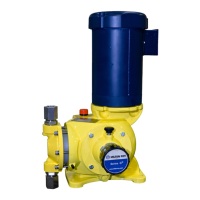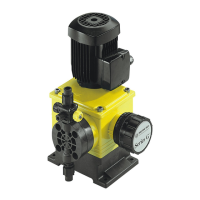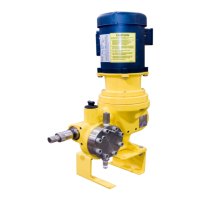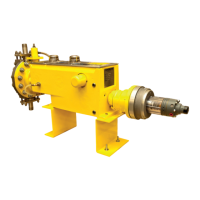Back Pressure Valves
A Milton Roy Back Pressure Valve should be installed in the discharge line near the pump to ensure
sufficient discharge head pressure for proper pump metering action. Normally, the valve should be located near
the pump; however, back pressure valves for large pumps with long and extremely small discharge lines may
have to be installed near the point of discharge into the process (to minimize siphoning tendencies).
Pulsation Dampeners
An accumulator, surge chamber, surge suppressor, or pulsation dampener should be used with the back
pressure valve in the discharge line to absorb the flow peaks between the pump and the back pressure valve.
Without the pulsation dampener the valve mechanism will snap open and closed with the surge from each pump
stroke. The pulsation dampener will allow the back pressure valve to oscillate about a partly-closed position, thus
minimizing wear on the valve. Discharge line pulsation dampeners offer the further advantage of limiting the flow
and pressure variations characteristic of this kind of pump. Installing a properly sized pulsation dampener will
improve pump performance and may reduce system costs dramatically by permitting the substitution of smaller
piping. Please contact Milton Roy Company for further information on pulsation dampeners.
Safety valves
Motor-driven positive displacement pumps can develop excessive discharge pressures long before
thermal overload devices interrupt the motor electrical circuit. To prevent a blocked discharge line from
causing damage to the pump, piping, or process equipment, install a Milton Roy Safety Valve in the pump
discharge line. This valve is designed and sized to handle system flow rates and pressures safely while
resisting corrosion by the process liquid.
Install the safety valve in the discharge line between the pump and the nearest shut-off valve. (This will prevent
pump damage from accidental valve closure.) Pipe the safety valve outlet back to the suction tank or to drain, but
in either case ensure that the pipe end is continuously visible so safety valve leakage may be detected. Milton
Roy safety valves must be installed at top of supply tank in order to function properly (see Figure 2-3).
Check Valves
A check valve should be installed at the point where the discharge line enters a boiler or other
high-pressure vessel. This will prevent back flow through the discharge piping and will isolate the pump
discharge from system pressures (a safety consideration).
Shut-of f Valves
Provide shut-off valves in both suction and discharge lines next to the pump. Locate discharge line shut-off
valve downstream from the inlet connection of the safety valve. Figure 2-3 shows recommended valve locations.
LEAK DETECTION
Without switch or gauge
Series G Model B pumps are equipped with a leak detection port. For ease of installation, each pump has
a plastic tubing connector installed in the leak detection port (see item 448 in Figure 6-2). In the event of a
failure of the oil seal (70 in Figure 6-1) or diaphragm assembly (see item 261 in Figure 6-2),pump drive oil or
process fluid will escape from this leakage port. During pump installation, actions should be taken to insure
that this leakage is safety collected by installing tubing between the leak detection port and an appropriate
containment vessel.
7

